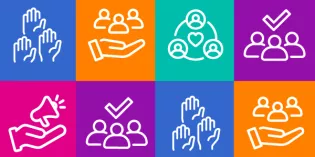
Introduction
When we first approached Rosamund Kissi-Debrah to ask her thoughts on how child health professionals could better communicate with CYP about air pollution she advised: ‘you just need to talk to them’. She talked about meeting them where they are, on common ground.
We realised that, for many of us, before we can talk about ‘tricky’ subjects like air pollution, we need to get the basics right and engage with CYP in everything that we do.
Perceptions of air quality among children and young people - report
What children think is different to adults. Children have good ideas, children have bigger imagination.
Including the perspectives of children and young people is key to informing future policy change.
RCPCH &Us is the College's programme for the voice of children, young people and families. It commissioned The Kaizen Partnership to undertake a UK-wide research and engagement project with over 1,000 children and young people living in areas most affected by air pollution.
The report from this project describes how young people perceive air quality, their knowledge of its health impacts and what action they believe should be taken. The vast majority of young people interviewed both understood the connection between air pollution and health problems and believed clean air should be a human right. They offered lots on possible policy changes and creative solutions.
You can download the full report at the bottom of this page.
Ten top tips for having a conversation about clean air - poster
The RCPCH &Us Climate Changers group of young people created a two-page poster with tips. These included: make things practical and relevant, consider your language and don't give ethical dilemmas.
View here or download the poster from the bottom of this page.
For the fifteen-minute consultation
This article by Gail Davison et al has some useful strategies for child-centred care. They summarise it: ‘help children be active agents in their own care by asking, listening well, being curious and explaining things clearly in an accessible but not condescending way.’
The below infographic explains four steps.

Some key takeaways are:
- Always say hello! Use your first name if possible, and say what your job is in simple language
- Be mindful of nonverbal communication such as waving (especially if a mask is obscuring your mouth) or if the room needs to be set up to be more inviting
- CYP say we are better at asking questions than listening to their answers – make sure you actively listen and respond
- Engaging young children or nonverbal young people in an activity may be more effective than conversation
- Make sure children are included in clinical decision-making
- Tell the truth
Children, though, are very perceptive and pick up non-verbal cues and what adults do not say. If we keep them in the dark, they tend to think the worst. The authors’ opinion, backed up by evidence, is that keeping secrets from children is futile; it is better to be honest than make them think twice about trusting you again.
Resources: RCPCH
There are some great examples within the RCPCH of how to have conversations around challenging topics:
The health inequalities tool on developing clinical skills for talking to families is one example. If we stop thinking about smoking, housing, food and air quality as “wider determinants” of health, and start considering them “core determinants”, then it doesn’t just become easier to ask about them: it becomes imperative.
This podcast between two of the toolkit's authors, Ian Sinha and Alice Lee, and RCPCH Officer for Health Improvement Helen Stewart also provides some helpful practical insights about starting conversations with patients and their families.
Resources: External
MeFirst is a super website that helps health and care professionals communicate more effectively with children and young people. It offers themed training modules and resources co-designed by children and young people.
AYPH (Association for Young People’s Health) work to meet the particular health and well-being needs of 10-25-year-olds. Their approach is rights-based and they have useful research on engagement such as their paper ‘How to talk about health inequalities in the context of young people’.
Want to learn more? Explore how to talk with CYP and families about this topic
- 1RCPCH (2024), RCPCH &Us Voice Bank, London: RCPCH (unpublished, available via and_us@rcpch.ac.uk)










